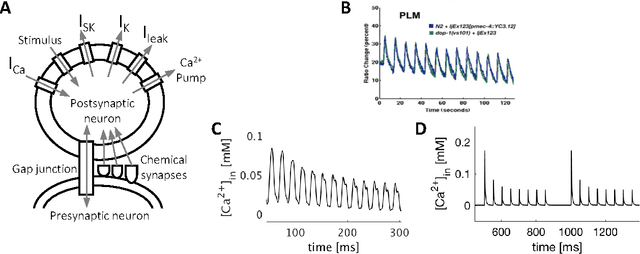Victoria Beneder
Non-Associative Learning Representation in the Nervous System of the Nematode Caenorhabditis elegans
Mar 25, 2017
Abstract:Caenorhabditis elegans (C. elegans) illustrated remarkable behavioral plasticities including complex non-associative and associative learning representations. Understanding the principles of such mechanisms presumably leads to constructive inspirations for the design of efficient learning algorithms. In the present study, we postulate a novel approach on modeling single neurons and synapses to study the mechanisms underlying learning in the C. elegans nervous system. In this regard, we construct a precise mathematical model of sensory neurons where we include multi-scale details from genes, ion channels and ion pumps, together with a dynamic model of synapses comprised of neurotransmitters and receptors kinetics. We recapitulate mechanosensory habituation mechanism, a non-associative learning process, in which elements of the neural network tune their parameters as a result of repeated input stimuli. Accordingly, we quantitatively demonstrate the roots of such plasticity in the neuronal and synaptic-level representations. Our findings can potentially give rise to the development of new bio-inspired learning algorithms.
SIM-CE: An Advanced Simulink Platform for Studying the Brain of Caenorhabditis elegans
Mar 25, 2017



Abstract:We introduce SIM-CE, an advanced, user-friendly modeling and simulation environment in Simulink for performing multi-scale behavioral analysis of the nervous system of Caenorhabditis elegans (C. elegans). SIM-CE contains an implementation of the mathematical models of C. elegans's neurons and synapses, in Simulink, which can be easily extended and particularized by the user. The Simulink model is able to capture both complex dynamics of ion channels and additional biophysical detail such as intracellular calcium concentration. We demonstrate the performance of SIM-CE by carrying out neuronal, synaptic and neural-circuit-level behavioral simulations. Such environment enables the user to capture unknown properties of the neural circuits, test hypotheses and determine the origin of many behavioral plasticities exhibited by the worm.
 Add to Chrome
Add to Chrome Add to Firefox
Add to Firefox Add to Edge
Add to Edge